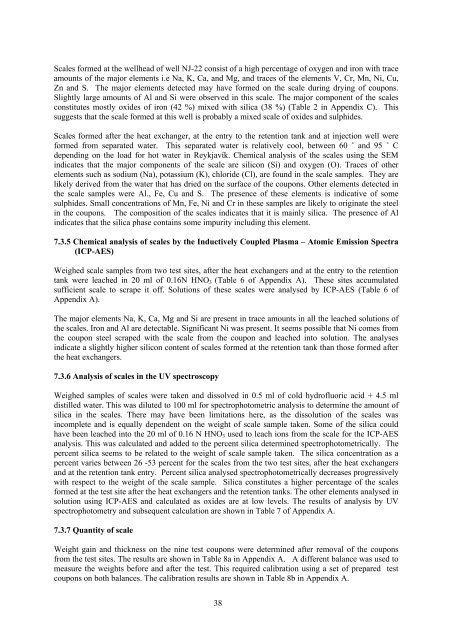corrosive species and scaling in wells at olkaria ... - Orkustofnun
corrosive species and scaling in wells at olkaria ... - Orkustofnun
corrosive species and scaling in wells at olkaria ... - Orkustofnun
You also want an ePaper? Increase the reach of your titles
YUMPU automatically turns print PDFs into web optimized ePapers that Google loves.
Scales formed <strong>at</strong> the wellhead of well NJ-22 consist of a high percentage of oxygen <strong>and</strong> iron with trace<br />
amounts of the major elements i.e Na, K, Ca, <strong>and</strong> Mg, <strong>and</strong> traces of the elements V, Cr, Mn, Ni, Cu,<br />
Zn <strong>and</strong> S. The major elements detected may have formed on the scale dur<strong>in</strong>g dry<strong>in</strong>g of coupons.<br />
Slightly large amounts of Al <strong>and</strong> Si were observed <strong>in</strong> this scale. The major component of the scales<br />
constitutes mostly oxides of iron (42 %) mixed with silica (38 %) (Table 2 <strong>in</strong> Appendix C). This<br />
suggests th<strong>at</strong> the scale formed <strong>at</strong> this well is probably a mixed scale of oxides <strong>and</strong> sulphides.<br />
Scales formed after the he<strong>at</strong> exchanger, <strong>at</strong> the entry to the retention tank <strong>and</strong> <strong>at</strong> <strong>in</strong>jection well were<br />
formed from separ<strong>at</strong>ed w<strong>at</strong>er. This separ<strong>at</strong>ed w<strong>at</strong>er is rel<strong>at</strong>ively cool, between 60 ˚ <strong>and</strong> 95 ˚ C<br />
depend<strong>in</strong>g on the load for hot w<strong>at</strong>er <strong>in</strong> Reykjavίk. Chemical analysis of the scales us<strong>in</strong>g the SEM<br />
<strong>in</strong>dic<strong>at</strong>es th<strong>at</strong> the major components of the scale are silicon (Si) <strong>and</strong> oxygen (O). Traces of other<br />
elements such as sodium (Na), potassium (K), chloride (Cl), are found <strong>in</strong> the scale samples. They are<br />
likely derived from the w<strong>at</strong>er th<strong>at</strong> has dried on the surface of the coupons. Other elements detected <strong>in</strong><br />
the scale samples were Al., Fe, Cu <strong>and</strong> S. The presence of these elements is <strong>in</strong>dic<strong>at</strong>ive of some<br />
sulphides. Small concentr<strong>at</strong>ions of Mn, Fe, Ni <strong>and</strong> Cr <strong>in</strong> these samples are likely to orig<strong>in</strong><strong>at</strong>e the steel<br />
<strong>in</strong> the coupons. The composition of the scales <strong>in</strong>dic<strong>at</strong>es th<strong>at</strong> it is ma<strong>in</strong>ly silica. The presence of Al<br />
<strong>in</strong>dic<strong>at</strong>es th<strong>at</strong> the silica phase conta<strong>in</strong>s some impurity <strong>in</strong>clud<strong>in</strong>g this element.<br />
7.3.5 Chemical analysis of scales by the Inductively Coupled Plasma – Atomic Emission Spectra<br />
(ICP-AES)<br />
Weighed scale samples from two test sites, after the he<strong>at</strong> exchangers <strong>and</strong> <strong>at</strong> the entry to the retention<br />
tank were leached <strong>in</strong> 20 ml of 0.16N HNO 3 (Table 6 of Appendix A). These sites accumul<strong>at</strong>ed<br />
sufficient scale to scrape it off. Solutions of these scales were analysed by ICP-AES (Table 6 of<br />
Appendix A).<br />
The major elements Na, K, Ca, Mg <strong>and</strong> Si are present <strong>in</strong> trace amounts <strong>in</strong> all the leached solutions of<br />
the scales. Iron <strong>and</strong> Al are detectable. Significant Ni was present. It seems possible th<strong>at</strong> Ni comes from<br />
the coupon steel scraped with the scale from the coupon <strong>and</strong> leached <strong>in</strong>to solution. The analyses<br />
<strong>in</strong>dic<strong>at</strong>e a slightly higher silicon content of scales formed <strong>at</strong> the retention tank than those formed after<br />
the he<strong>at</strong> exchangers.<br />
7.3.6 Analysis of scales <strong>in</strong> the UV spectroscopy<br />
Weighed samples of scales were taken <strong>and</strong> dissolved <strong>in</strong> 0.5 ml of cold hydrofluoric acid + 4.5 ml<br />
distilled w<strong>at</strong>er. This was diluted to 100 ml for spectrophotometric analysis to determ<strong>in</strong>e the amount of<br />
silica <strong>in</strong> the scales. There may have been limit<strong>at</strong>ions here, as the dissolution of the scales was<br />
<strong>in</strong>complete <strong>and</strong> is equally dependent on the weight of scale sample taken. Some of the silica could<br />
have been leached <strong>in</strong>to the 20 ml of 0.16 N HNO 3 used to leach ions from the scale for the ICP-AES<br />
analysis. This was calcul<strong>at</strong>ed <strong>and</strong> added to the percent silica determ<strong>in</strong>ed spectrophotometrically. The<br />
percent silica seems to be rel<strong>at</strong>ed to the weight of scale sample taken. The silica concentr<strong>at</strong>ion as a<br />
percent varies between 26 -53 percent for the scales from the two test sites, after the he<strong>at</strong> exchangers<br />
<strong>and</strong> <strong>at</strong> the retention tank entry. Percent silica analysed spectrophotometrically decreases progressively<br />
with respect to the weight of the scale sample. Silica constitutes a higher percentage of the scales<br />
formed <strong>at</strong> the test site after the he<strong>at</strong> exchangers <strong>and</strong> the retention tanks. The other elements analysed <strong>in</strong><br />
solution us<strong>in</strong>g ICP-AES <strong>and</strong> calcul<strong>at</strong>ed as oxides are <strong>at</strong> low levels. The results of analysis by UV<br />
spectrophotometry <strong>and</strong> subsequent calcul<strong>at</strong>ion are shown <strong>in</strong> Table 7 of Appendix A.<br />
7.3.7 Quantity of scale<br />
Weight ga<strong>in</strong> <strong>and</strong> thickness on the n<strong>in</strong>e test coupons were determ<strong>in</strong>ed after removal of the coupons<br />
from the test sites. The results are shown <strong>in</strong> Table 8a <strong>in</strong> Appendix A. A different balance was used to<br />
measure the weights before <strong>and</strong> after the test. This required calibr<strong>at</strong>ion us<strong>in</strong>g a set of prepared test<br />
coupons on both balances. The calibr<strong>at</strong>ion results are shown <strong>in</strong> Table 8b <strong>in</strong> Appendix A.<br />
38

















